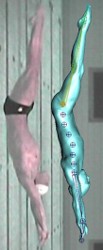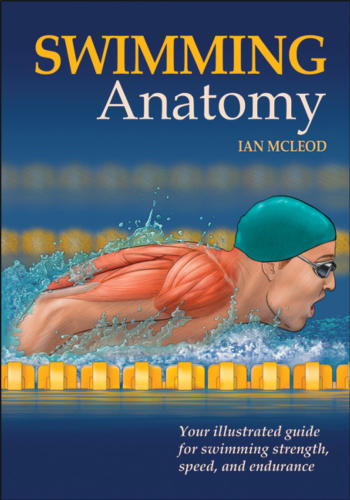 Although backstroke is unique in body positioning among the competitive strokes, the stroke phases can still be divided into a propulsive phase that consists of hand entry into the water, a catch component, a finishing component, and a recovery phase. Rotation at the shoulder puts the hands in a position in which the little finger is the first to enter the water. Combined with extension of the elbow, the swimmer is in an elongated position to begin the underwater propulsion phase of the stroke. A difference between backstroke and freestyle or butterfly is that the initial catch component is dominated by the latissimus dorsi. The pectoralis major makes a smaller contribution. Despite these differences the latissimus dorsi and the pectoralis major are still the prime movers and are active to some degree throughout the entire propulsive phase. Although the wrist flexors are still an integral part of the entire propulsion phase, the wrist is maintained in a neutral to slightly extended position.Through a combination of pressure forces from the water and activation of the biceps brachii and brachialis, the elbow transitions into approximately 45 degrees of flexion at the start of the catch. By the end of the catch the elbow may be flexed as much as 90 degrees just before transitioning into the finishing component. As with the finishing component in butterfly, more emphasis is placed on forceful extension of the elbow, placing high demand on the triceps brachii during the final portion of the propulsive phase.
Although backstroke is unique in body positioning among the competitive strokes, the stroke phases can still be divided into a propulsive phase that consists of hand entry into the water, a catch component, a finishing component, and a recovery phase. Rotation at the shoulder puts the hands in a position in which the little finger is the first to enter the water. Combined with extension of the elbow, the swimmer is in an elongated position to begin the underwater propulsion phase of the stroke. A difference between backstroke and freestyle or butterfly is that the initial catch component is dominated by the latissimus dorsi. The pectoralis major makes a smaller contribution. Despite these differences the latissimus dorsi and the pectoralis major are still the prime movers and are active to some degree throughout the entire propulsive phase. Although the wrist flexors are still an integral part of the entire propulsion phase, the wrist is maintained in a neutral to slightly extended position.Through a combination of pressure forces from the water and activation of the biceps brachii and brachialis, the elbow transitions into approximately 45 degrees of flexion at the start of the catch. By the end of the catch the elbow may be flexed as much as 90 degrees just before transitioning into the finishing component. As with the finishing component in butterfly, more emphasis is placed on forceful extension of the elbow, placing high demand on the triceps brachii during the final portion of the propulsive phase.
The role of the stabilizing musculature during backstroke is similar to the role that it plays in freestyle, largely because of the similar reciprocal arm movement and the integration of body roll into both strokes.
The kicking motion seen in backstroke is a combination of movements that we have seen in freestyle and butterfly kicking mechanics. Like freestyle, backstroke uses reciprocal kicking movements. The major difference is that the position of the swimmer causes most of the force to be generated during the upbeat portion of the kick as opposed to the downbeat in freestyle. Backstroke also uses the dolphin kick off the start of a race and off each wall. The muscle recruitment patterns are the same in each case; the only change is in the direction because of the swimmer's body position..

